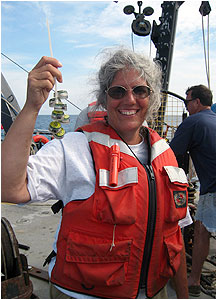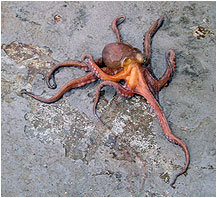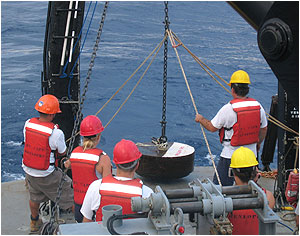 |
|
 |
 |
 |
 |
ARMADA teacher Cathy Roberts proudly displays tiny temperature-logging Tidbits during the mooring recovery.
photo © C. Good, Duke U.
|
 |
 |
 |
Frank's 8-armed buddy.
photo © G. Gawarkiewicz
|
Cruise - 2004 - R/V Cape Henlopen
Dispatch 05 - 13 August 2004
Previous
dispatch... Back
to cruise index
Heading Home
by Glen Gawarkiewicz
We are presently steaming to Lewes. The weather is getting rougher
as two tropical storms are approaching. The last few days have been
quite eventful.
On Wednesday night, we recovered Dana Savidge's acoustic Doppler
current profiler (ADCP) mooring near Cape Hatteras, in 29 meters of
water. As we put the bottom mount on the deck, a large octopus
scrambled out past Frank Bahr's leg. It was a brownish red. As
Frank was hurling it over the stern, a second one also climbed out.
After this, we did a section across the shelf very close to Cape
Hatteras, beginning just off the fish pier at Avon, NC. It was
dark, and as we were just a quarter mile offshore, we could easily
see bonfires on the beach, a fireworks display, and Wynn Tucker's
favorite bar (Pop's). We encountered Gulf Stream
water along the bottom, practically on the beach, overlain by a
thin layer of cool, fresh shelf water from further north.
On Thursday, the day began with Teresa Garner deploying the OS200,
a fast temperature/conductivity instrument used to study ocean
mixing processes. She was able to do four drops at one station
before we recovered our large surface buoy. Luckily, the seas
were not too rough (3-4 feet), and Craig Marquette and Tim North
were able to deftly recover the large buoy as well as the tripod
nearby which held the WHOI ADCP. The tripod had a small octopus
draped on one of its leg. The octopus actually slithered across
the deck to the stern, where it promptly jumped into the ocean.
 |
 |
Bringing the anchor back on deck after the successful mooring deployment.
photo © C. Good, Duke U.
|  |
We were less fortunate recovering Dana Savidge's northern ADCP
mooring. The acoustic release indicated that a buoyant ball had
been sent up to the surface, but we were unable to spot a ball
and suspect that the attached line was fouled. Dana will send a diver
soon to recover. After this, Teresa, along with Jim Churchill,
did more OS200 drops, extending into the evening. During one of
the sections we had several Portuguese Man of Wars drift by the
ship.
During Thursday night, we were hit by another cold front. A
strong squall line hit as we were going to redeploy the Scanfish.
There were lightning flashes all around the ship, and 30 knot
winds with driving rain. After a two hour delay, we deployed
the Scanfish and did one final section across the shelfbreak at
the northern edge of our study area.
During the past two weeks, we have been hit by one hurricane, two
cold fronts with 30 knot winds, and have deployed and recovered
five moorings in two knot currents. We have mapped the frontal
structures north of Cape Hatteras as well as the marine mammals,
studied the ocean mixing processes in an area of strong current
shears, and seen Gulf Stream water intruding onto the continental
shelf in a wide variety of thermohaline intrusions. The data sets
will keep us busy with analysis for a long time in the future.
Despite the rough seas, the crew of the R/V Cape Henlopen
has kept us happily and safely working throughout. Our heartfelt thanks
go out to Bill Byam, Jimmy Warrington, Chuck Baird, Tim North, Sandy
Parks, Mike Popovich, Brian Kidd, Wynn Tucker, Shannon Freeman, and
Tim Travers. None of our science would be possible without their hard
work and sacrifices.
|
 |
|



